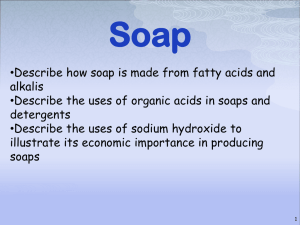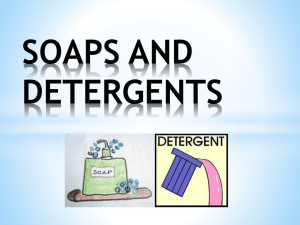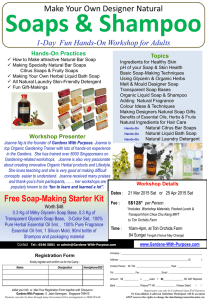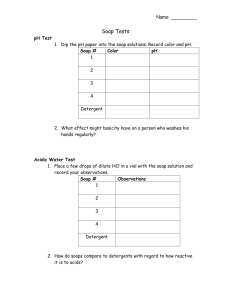Health Products 5
advertisement
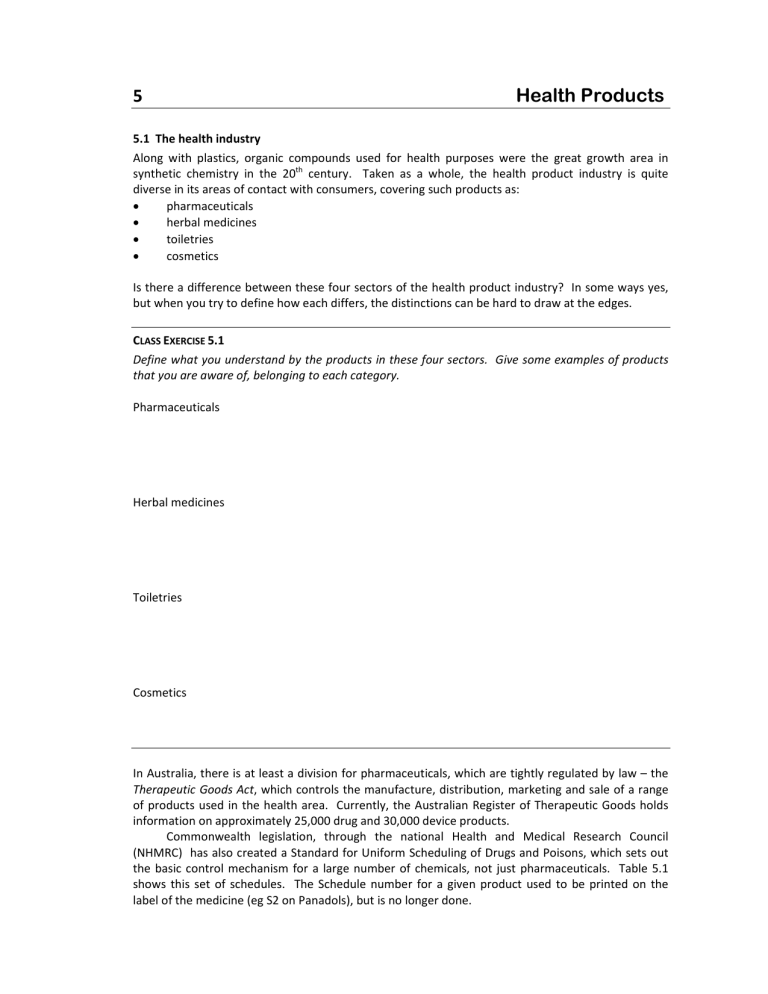
5 Health Products 5.1 The health industry Along with plastics, organic compounds used for health purposes were the great growth area in synthetic chemistry in the 20th century. Taken as a whole, the health product industry is quite diverse in its areas of contact with consumers, covering such products as: pharmaceuticals herbal medicines toiletries cosmetics Is there a difference between these four sectors of the health product industry? In some ways yes, but when you try to define how each differs, the distinctions can be hard to draw at the edges. CLASS EXERCISE 5.1 Define what you understand by the products in these four sectors. Give some examples of products that you are aware of, belonging to each category. Pharmaceuticals Herbal medicines Toiletries Cosmetics In Australia, there is at least a division for pharmaceuticals, which are tightly regulated by law – the Therapeutic Goods Act, which controls the manufacture, distribution, marketing and sale of a range of products used in the health area. Currently, the Australian Register of Therapeutic Goods holds information on approximately 25,000 drug and 30,000 device products. Commonwealth legislation, through the national Health and Medical Research Council (NHMRC) has also created a Standard for Uniform Scheduling of Drugs and Poisons, which sets out the basic control mechanism for a large number of chemicals, not just pharmaceuticals. Table 5.1 shows this set of schedules. The Schedule number for a given product used to be printed on the label of the medicine (eg S2 on Panadols), but is no longer done. 5. Health Products TABLE 5.1 NHMRC Drug & Poison Schedules Schedule Property of Poison Availability 1 Not currently in use (applied to substances not in normal use) 2 Drugs (medicinal poisons for therapeutic use) Pharmacy retail 3 Drugs of higher potency Restricted pharmacy retail 4 Prescription (dangerous) drugs Medical/dental/veterinary prescription 5 Domestic poisons General retail 6 Industrial and agricultural poisons Restricted retail 7 Special poisons (including industrial chemicals) Restricted wholesale 8 Drugs of addiction Restricted medical/dental/vet prescription 9 Prohibited substances CLASS EXERCISE 5.2 Provide an example of each of the classes of goods. Schedule Examples 2 3 4 5 6 7 8 9 5.2 Pharmaceuticals The use of chemical substances to deal with health problems dates back into ancient history. There are references in ancient Egyptian records (1550 BC) to the use of plant materials for curing disease (or at least attempting to!). During the 19th century, the extraction, isolation and examination of active components of plant materials became common. Early medications were mainly alkaloids – nitrogen‐containing organic compounds with a bitter flavour, and very often highly pharmaceutically active. The toxic properties of the mandrake, poppy and nux vomica plants are due in most part to their alkaloid constituents, atropine, morphine and strychnine, respectively. Nicotine and caffeine are also alkaloids. IPC 5.2 5. Health Products Examples of non‐alkaloid compounds, now widely used as modern pharmaceuticals, which were originally derived from plant origins are aspirin, which was isolated from willow bark potions used to treat pain and fever, and ephedrine (a bronchodilator ‐ opens the breathing tubes in the lungs) which was isolated from a Chinese herbal remedy. The structures of these compounds are shown in Figure 5.1. Today most drugs are manufactured rather than extracted from other plants and animals (although genetic engineers are reversing this trend). Table 5.2 shows the evolution of the pharmaceutical industries, through important discoveries. Table 5.3 shows the most commonly used pharmaceuticals worldwide and in Australia. TABLE 5.2 A brief history of the development of the pharmaceutical industry 1785 1803 1818 1820 1831 1844 1846 1847 1867 1876 1884 1898 1899 1902 1903 1905 1907 1910 1911 1912 1921 1929 1933 1935 1936 1937 1941 1943 1948 1950 1952 Use of digitalis for heart disease Morphine isolated from opium poppy Strychnine isolated Quinine isolated from cinchona bark Atropine isolated Nitrous oxide used as an anaesthetic Ether used as an anaesthetic in surgery Chloroform used as an anaesthetic Amyl nitrite used for angina Salicylates found to be painkillers Cocaine found to be local anaesthetic Barbital used as sedative Aspirin synthesised and marketed by Bayer Adrenalin isolated from the adrenal gland Veronal (barbital – the first barbiturate) synthesised Organic arsenic compounds used for treatment of syphilis Ergot alkaloids found to counteract adrenaline Non‐arsenic compound (salvarsan) used against syphilis Vitamin studies started Phenobarbital used as anti‐epilepsy treatment Insulin isolated Penicillin discovered Vitamin C synthesised Antibacterial activity of sulfonamides discovered and used on humans Pethidine, the first synthetic narcotic, synthesised Antihistamines discovered Penicillin first used for treatment of infection Diphenylhydramine becomes the first practical antihistamine Chlortetacycline and chloramphenicol (antibiotics) discovered Development of the first major tranquiliser, chlorpromazine Tetracycline discovered First anti‐inflammatory steroids synthesised 1957 Imipramine used as antidepressant 1960 Oral drugs for mature onset diabetes. post 1960 It gets really busy!! IPC 5.3 5. Health Products (a) (b) (c) N CH3 CH3 N N O HO O N O HO OH O O (e) (d) CH3 CH3 N N N N O N N CH3 CH3 O FIGURE 5.1 Common alkaloids (a) atropine (b) morphine (c) strychnine (d) nicotine (e) caffeine TABLE 5.3 The most prescribed drugs in Australia (12 months to June 30, 1996) Item Example of drug name Drug Type No. of scripts (‘000s) Paracetamol Panamax Analgesic 3,754 Simvastatin Zocor Cholesterol reducing 2,871 Panadeine Analgesic 2,704 Enalapril Renitec Blood pressure 2,519 Ranitidine Zantac Antacid (ulcers) 2,475 Temazepam Normison Sedative 2,362 Salbutamol Ventolin Anti‐asthmatic 2,078 Atenolol Tenormin Beta‐blocking agent 1,930 Fluvax Vaccine 1,715 Oxazepam Serepax Sedative 1,423 Diazepam Valium Sedative 1,175 Frusemide Lasix Diuretic 1,103 Amoxycillin Amoxil Antibiotic 1,087 Roxithromycin Rulide Antibiotic 987 Isosorbide Imdur Cardiac therapy 980 Paracetamol + codeine Influenza vaccine IPC 5.4 5. Health Products How Does a Drug Work? This is a very difficult question to answer as there are thousands of drugs and thousands of different modes of drug action, but many drugs work on the principle that their specific shape, size and localised chemical structures (eg functional groups, polarity, charge) allows them to bind to an active site in the body, and this causes a desirable effect (such as suppression or release of a pain causing substance etc.). From this you may deduce that the three dimensional shape of many drugs is vitally important for them to work. This is why it is often less expensive to obtain drugs from nature rather than manufacture them, as nature uses enzymes which get all of the chiral centres shaped just right. If even one chiral centre is wrong the chances are that the drug will be the wrong shape and therefore totally inactive. Developing a Pharmaceutical Product Pharmaceutical products are simply not discovered and sold. There are many steps in between the discovery of a substance with important pharmaceutical properties, and its appearance in the pharmacists shop. These steps would normally take up to 10 years, as rigorous government codes control the sale and development of any product intended for pharmaceutical use. The steps involved in the development of a typical prescription pharmaceutical product include; discovery of the active substance isolation of the active compound toxicological testing and clinical trials sale under prescription Generally it is only a small part of the structure of an active drug which is responsible for the pharmaceutical effect (see Figure 5.2 for a series of local anaesthetics). Often undesirable side effects (such as addiction and hallucinogenic episodes) can be reduced or removed from a commercial product as they are caused by a different part of the chemical structure. Hence the chemist’s job is: 1. to identify the active substance in a pharmaceutical preparation 2. to identify the parts of the chemical structure of active substance which give rise to the desired effect (an those which cause undesirable side effects) 3. to design and prepare (a) (b) CH3 O N CO2CH3 O N H H2N O H C O (c) (d) CH3 NH O CCH2N CH2CH3 CH2CH3 O H2N CH3 O FIGURE 5.2 Common local anaesthetics (a) cocaine (b) procaine (c) xylocaine (d) benzocaine IPC 5.5 5. Health Products Pharmaceuticals of a particular class (eg local anaesthetics) are also designed to meet other requirements, such as length of duration. This is essentially reflected by the rate at which the compound is decomposed (metabolised) in the body. The slower it is broken down, the longer it will remain active in the body. This is often achieved by “tinkering around the edges” of the active part of the structure, changing the attached chains or introducing groups that allow more rapid breakdown. Table 5.4 shows the half‐lives of some common drugs: the time for half of the dose to be metabolised in the body. TABLE 5.4 Half‐lives of common drugs in the body Drug Aspirin Amoxycillin Time (hours) 0.25 1 Caffeine 4‐6 Cocaine 0.5‐1 Diazepam 12‐24 Erythromycin Nicotine 1‐2 1.5‐2.5 Nitroglycerine 2 minutes Phenobarbital 100 Phenylbutazone 60 Streptomycin 4‐6 Tetracycline 10‐12 The synthesis of modern pharmaceuticals is exceedingly complex and the organic chemistry is very involved. Firstly, the drugs are quite complex in their structure, and secondly, they need to be made on an industrial scale, even though they will be first made in the laboratory. Important Classes of Pharmaceutical Products There are now huge numbers of prescription drugs on the market. It would be almost impossible to cover them , even briefly in this course so we will choose a few of the more important classes any examine their chemical structures and its link to biological activity. Some of the more important classes of drugs include: analgesics ‐ responsible for alleviating pain general anaesthetics ‐ used to place the patient in an unconscious state local anaesthetics ‐ used to prevent the patient feeling pain in a specific area of the body tranquilisers ‐ promote a feeling of calm and remove stress stimulants ‐ increase the rate of biological activity of the recipient sedatives – reduce worry and anxiety antibacterial agents ‐ kill bacterial infestations anti‐inflammatory agents ‐ prevent tissue inflammation (swelling and reddening) IPC 5.6 5. Health Products 5.3 Complementary Medicines Complementary medicines include herbal or traditional medicines, together with vitamins and mineral supplements. The herbal extract group is based on thousands of years of tradition in various cultures, eg Chinese, where certain extracts from natural materials (plant and animal) are known to be medically effective, though hard scientific proof may not be necessarily available. Vitamins and minerals are proven dietary requirements, a deficiency of which is associated with various health problems, eg vitamin C with scurvy. Some diets may be lacking in one or more of the substances, therefore requiring a top‐up by way of a capsule or tablet. These products are not subject to the same level of control as the mainstream pharmaceuticals. In Australia, they still require listing, but not registration under the Therapeutical Goods Administration. Listed medicines are usually considered to be relatively benign, so the regulations allow for sponsors to 'self assess' their products in some situations The majority of Listed medicines are self‐ selected by consumers and used for self‐treatment. They are all unscheduled medicines (i.e. not described in the SUSDP) with well‐known established ingredients, usually with a long history of use, such as vitamin and mineral products or sunscreens. These are assessed by the TGA for quality and safety but not efficacy. This does not mean that they do not work. It simply means that the TGA has not evaluated them individually to see if they work. It is a requirement under the Act that sponsors hold information to substantiate all of their product's claims. 5.4 Surfactants Polar and non‐polar substances do not mix under normal circumstances. Surfactants are special substances whose molecules possess both polar and non‐polar portions which encourage two normally immiscible substances to mix. The polar portion of the molecule can be ionic (positively or negatively charged or both) or possess polar organic functional groups (eg OH), and will be a relatively small part of the molecule. It is often referred to as the head. The non‐polar portion of the molecule will be organic, and feature a long chain of carbons atoms, sometimes purely singly‐bonded, sometimes with a few double bonds, and in some cases, an aromatic ring. The chain can be straight or branched. It will be the larger portion of the molecule, and is often referred to as the tail. Figure 5.2 shows the structure of a generic surfactant. non-polar tail polar head FIGURE 5.2 A generic surfactant The term surfactant in general means surface active agent, and applies to all substances which allow polar and non‐polar substances to mix. The most common examples of this are soaps, detergents and emulsifying agents. In this chapter we will examine the chemical and physical properties of these substances, and discuss some typical applications. Soap The term soap refers to any molecule with the general formula RCOO‐Y+ where R = a long hydrocarbon chain CH3(CH2)10‐16 and Y = Na+ or K+, i.e. the salt of a long chain alkanoic acid. Figure 5.3 below shows a typical soap molecule. IPC 5.7 5. Health Products O + Na O FIGURE 5.3 Typical soap molecule ‐ sodium palmitate Soap Manufacture Soaps are normally produced by the hydrolysis of triglycerides with strong alkalis such as sodium or potassium hydroxide. EXERCISE 5.3 What is the structure of a typical triglyceride? The least expensive source of triglycerides are animal fats and vegetable oils, hence soaps are normally produced, which is essentially just the reverse of the esterification reaction which produces the triglyceride. This reaction is known as saponification. EXERCISE 5.4 (a) Draw the structure of the products of the saponification by NaOH of the following triglyceride. CH2-O-CO-(CH2)13CH3 CH-O-CO-(CH2)15CH3 CH2-O-CO-(CH2)13CH3 (b) What type of molecule is the soap molecule – acid, base, neutral? The properties of the soap are determined by: the nature of the cation, and the length and functionality of the non‐polar region of the molecule. Soaps produced using sodium hydroxide (sodium salts of fatty acids), are known as hard soaps and are generally used in the production of cake soaps for the bathroom and laundry. Those produced from potassium salts are known as soft soaps, and are generally used in liquid soap preparation and as shaving creams. IPC 5.8 5. Health Products Cations other than sodium and potassium (eg calcium and magnesium) tend to produce insoluble soap compounds (eg the so‐called “ring around the bath”), and are the cause of soap failure in hard water (no lathering or cleaning action) The use of different triglycerides in the manufacturing process also modifies the properties of soap. The most common sources of triglycerides are beef fat (commonly known as tallow) and palm oil. Beef fat gives a soap which is principally sodium stearate, whilst palm oil gives a soap which is mostly sodium palmitate. Other special purpose soaps use more exotic triglycerides, such as tea tree oil, or avocado to change the cleansing properties of the soap or to provide some mild antiseptic action (medicated soaps). Detergents Soaps are good cleaning agents, in that they are biodegradable (are readily broken down by bacteria), and inexpensive, but they do not work in hard water areas and their alkalinity can be a problem in some circumstances. For this reason other surfactant molecules have been developed which do work in hard water and are not manufactured from fatty acid anions. Detergents are synthetically produced surfactant molecules. Like soaps, they contain a polar head and a non‐polar tail. The tail portion is again a long hydrocarbon chain or a hydrocarbon chain with branches and/or aromatic groups substituents, but the head group is a species which will not form precipitates in hard water. There are four basic polar group types: anionic ‐ have a head group which carries a negative charge like soap molecules, but have a different functional group, such as a sulfonic acid salt (SO3‐); an example of this is a alkyl sulfonate shown in Figure 5.4(a) cationic ‐ have a head group which carries a positive charge such as a alkylammonium group (NR3+) (see Figure 5.4(b)) non‐ionic ‐ have a polar non‐ionic head group such as a polyalkanol (see Figure 5.4(c)) amphoteric ‐ carry both positive and negative head groups (see Figure 5.4(d)) (a) sodium lauryl sulfate O S O Na + O (b) cetyl trimethyl ammonium bromide N(CH3)3+ Br (c) lauryl alcohol ethoxylate CH3(CH2)10CH2O(CH2CH2O)5CH2CH2OH (d) coco imidazoline betaine IPC 5.9 5. Health Productss CH3 N+--CH2COO-CH3 FIGUR RE 5.4 Structurres of typical surfactants (a) an nionic (b) cation nic (c) non‐ionicc (d) amphoteriic TABLEE 5.5 Common applications a off different surfactant types Surfa actant Type Applicattions Anion nic Cleaningg – hard water hand d washing, dishwashin ng liquids, toothpaste,, shampo oo, carpet cleeaner Catio onic Mouthw wash, fabric softener, s bacctericide Non‐ionic Emulsifyying agents (foods, cosmetics) hoteric Amph Shower gel, hair shaampoo for seensitive skinss (eg babies) Surfa actant behavviour When n a very sm mall amount of surfactan nt is added to water, the t molecule es dissolve through t the e solveent, but are unstable u because of the large l hydrocarbon chains. Thereforee, as more molecules m are e added, they tend d to gather into i small cllusters called d micelles (aas shown in Figure 5.5).. Moleculess mselves in a single layer (known as a monolayer) so that th he non‐polarr near the surface orient them ns stick out in nto the air (ssee Figure 5.6 6). chain FIGUR RE 5.5 A micelle FIGUR RE 5.6 Surface monolayer m ning ability Clean Dirt, grease, oil and a similar materials m are e mixtures off non‐polar substances, s which is whyy they don’tt a The T bipolar nature n of surfactant mollecules allow ws the dirt to o wash away in watter without assistance. w and rin nsed away by creating sm mall “drople ets” of dirt su urrounded by b surfactantt be dispersed in water (essentially the saame as a purre micelle) (ssee Figure 5.7). IPC 5.10 5. Health Products FIGURE 5.7 The cleaning process Emulsification These are colloids formed between oil and water e.g. mayonnaise, margarine, cosmetic creams. These come in two forms: oil/water emulsions ‐ where the oil is the dispersed phase (equivalent to the solute) and the water is the dispersing medium (equivalent to the solvent), e.g. mayonnaise. water/oil emulsions ‐ where the opposite is the case i.e. water is the dispersed phase and oil is the dispersing medium, e.g. cream. Surfactants are used to stabilise emulsions (known as emulsification), by forming micelles and preventing re‐agglutination of the oily droplets. It is basically the same process that occurs in cleaning a greasy surface, differing only in that the proportions of the two phases are likely to be closer together. Biodegradability The term biodegradable with regard to surfactants refers to the natural decomposition of the surfactant substance by micro‐organisms commonly found in our waterways. The first detergents were branched chain sulfonates. The branching prevented bacteria and other natural organisms from breaking the compounds down, meaning that they accumulated in waterways, causing substantial problems, such as foaming, suffocation of marine organisms and high biological oxygen demand Newer surfactants, such as alkylbenzene sulfonates (ABS) and linear alkyl sulfonates (LAS), are designed so that they biodegrade much faster than older surfactants. IPC 5.11 5. Health Products 5.5 Toiletries and cosmetics Cosmetics and toiletries are substances which are mostly applied to the outside surface of the body (almost always the skin) to improve the feeling of well being of those being treated. In general they are not used to improve health, but some are used to prevent damage or infection of the body. In general the terms cosmetic and toiletry are too closely related to distinguish, and apply to the following classes of products: make up perfumes and fragrances body soaps hair shampoos and conditioners toothpaste skin care products (including moisturisers, cleansers and lotions) deodorants sunscreens Some of these products are examined in the following parts of this chapter. Sunscreens Sunburn is caused by irradiation of the cells in the skin with excessive amounts of UV light. This causes cellular damage by opening little pockets of enzymes which attack the cell causing pain. The body has a natural response to UV exposure whereby it increases the concentration of a skin pigment called melanin. This limits further cellular absorption of UV light, but is a slow process. Sunscreens act to limit the amount of UV‐visible light reaching the skin by absorbing it and allowing tanning to proceed at a much slower and safer rate. Substances which are effective sunscreens must contain chemical groups which will absorb UV light in the region of 290‐320nm (known as UV‐B, UV‐A is higher wavelength, UV‐C lower), but allow transmission of other light frequencies. The substances which do this best contain an aromatic ring. The efficiency of a sunscreen is measured by its sunscreen protection factor (SPF). Typical values are 4, 8, 15 and 30+. The number is a ratio of the amount of time skin protected by the sunscreen takes to redden compared to unprotected skin. An higher SPF is due to higher concentrations of the absorbing compound. A SPF4 may have 2‐3% of absorber, while SPF30+ will have up to 20%. Soaps & detergents As you have seen in the Surfactants section, these do the same thing, but differ chemically and in their source of production: soaps from animal and plant fats, detergents from synthetic sources. Their properties are determined by: the nature of the polar head, and the length and functionality of the non‐polar region of the molecule. Soaps produced using sodium hydroxide (sodium salts of fatty acids), are known as hard soaps and are generally used in the production of cake soaps for the bathroom and laundry. Those produced from potassium salts are known as soft soaps, and are generally used in liquid soap preparation and as shaving creams. In Australian personal soaps, the fatty acid content must be greater than 70%. Cations other than sodium and potassium (eg calcium and magnesium) tend to produce insoluble soap compounds (eg the so‐called “ring around the bath”), and are the cause of soap failure in hard water (no lathering or cleaning action) The use of different triglycerides in the manufacturing process also modifies the properties of soap. The most common sources of triglycerides are beef fat (commonly known as tallow) and palm oil. Beef fat gives a soap which is principally sodium stearate, whilst palm oil gives a soap which is IPC 5.12 5. Health Products mostly sodium palmitate. Other special purpose soaps use more exotic triglycerides, such as tea tree oil, or avocado to change the cleansing properties of the soap or to provide some mild antiseptic action (medicated soaps). Soaps are good cleaning agents, in that they are biodegradable (are readily broken down by bacteria), and inexpensive, but they do not work in hard water areas and their alkalinity can be a problem in some circumstances. For this reason other surfactant molecules have been developed which do work in hard water and are not manufactured from fatty acid anions. Toothpastes Toothpaste performs three basic functions: removal of stain from the teeth improve the health of teeth and gums freshening of the breath and mouth Mild abrasives, fluoride and various flavours, respectively achieve these purposes. These ingredients must be presented in a medium to allow convenient consumer use. This is normally a soft paste, whose rheology – the study of the deformation and flow of materials – is absolutely critical in determining the usability of the product. TABLE 5.7 Ingredients of toothpastes Ingredient Function Examples Typical %w/w Abrasive Helps to remove stains and adhered particles Calcium carbonate Hydrated silica 15‐50 Humectant To provide a creamy base which doesn’t dry out Sorbitol 20‐50 Binder To improve the rheology Carboxymethyl cellulose Calcium carrageenate 10 Surfactant To provide foam and cleaning action Sodium lauryl sulfate 1‐2 Flavour To improve mouth freshness and flavour of paste Peppermint oil, saccharin 1‐2 Active agents To improve health of teeth and gums Fluoride Water To assist formulation Others Colour/fragrance/ preservatives IPC 1 20 Sodium benzoate (pres.) 1 5.13
